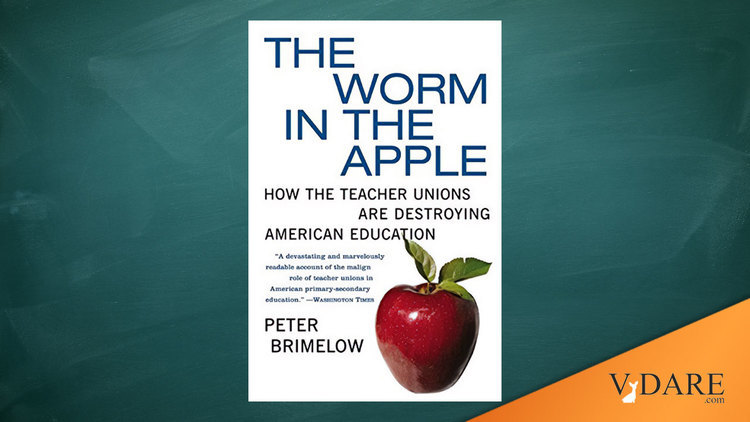


03/05/2003
Republished on VDARE.com on March 05, 2003
By Thomas Bray
The Detroit News
February 23, 2003
When former Detroit Supt. David Adamany once proposed a modest incentive-pay system to reward teacher excellence, the Detroit affiliate of the American Federation of Teachers reacted bluntly: Any such move would provoke a strike. Adamany, who soon left to become president of Temple University, was forced to back off.
The confrontation underlined the clear priorities of leaders of the AFT and the far larger National Education Association: union solidarity first, children and parents second. Teachers unions style themselves liberal politically. In fact, they are reactionary — as Peter Brimelow, a journalist who has written for Forbes and Fortune, makes clear in "Worm in the Apple: How the Teachers Unions Are Destroying American Education" (HarperCollins, $24.95).
Brimelow, citing a 1999 survey showing that 55 percent of the students at leading colleges couldn’t identify Valley Forge, words from the Gettysburg Address or basic principles of the Constitution, starts by asking: "How has America, victorious in the Cold War, the world’s richest country and its sole remaining superpower, been brought to the point where its very origins are unknown to young adults?" He then goes on to make a powerful case that as the power of teachers unions has waxed, student achievement has waned.
"There were essentially no teachers in collective bargaining units in 1962," he notes, "when average SAT (scholastic aptitude tests) stood at their highest point. Twenty years later, scores had slipped down, by about 10 percent or so." Particularly damning is the fact that while fourth graders hold their own in comparisons among industrialized countries, they have slipped to well below average in science and math by the eighth grade.
The public school system is not just failing. It is damaging its young charges — particularly minorities. That’s one reason why elite public institutions like the University of Michigan must offer large preferences to enroll what it calls a "critical mass" of them. Public colleges and universities alone are spending $1 billion a year in remedial course work.
There are no doubt many reasons for the lackluster performance. But it’s striking that the United States spends 25-33 percent more on K-12 education than all other industrial nations except Belgium and Austria. Spending comes to more than $7,000 per pupil, up from an inflation-adjusted $4,903 when the famous "Nation at Risk" study sounded the alarm about U.S. education in 1982. Despite union complaints about tough working conditions, the number of pupils per teacher has steadily declined to 16.5 from 18.7 in 1980 — and 36.7 in 1900.
To sustain their grasp on power, teachers unions have turned to political activism on a grand scale. At the local level, they back candidates sympathetic to their cause. Most parent-teachers associations have been turned into little more than fronts for the unions. The unions led successful campaigns recently against vouchers in California and Michigan and have blocked expansion of the charter school movement, despite long waiting lists of desperate parents.
Brimelow estimates that national and local NEA affiliates spent a stunning $50 million on federal candidates in the 1999-2000 election cycle. That’s nearly 10 percent of the total spent by all PACs.
The statistics are fairly clear about what would happen to union dues if public school students could escape the clutches of what Brimelow calls the teachers trust. A study by the Mackinac Center for Public Policy in Midland showed that while all 583 Michigan school districts are unionized, only five of 139 charter schools — and two of more than 1,000 private schools — are collectivized.
Competition for students thus would threaten the dues that sustain a fairly cushy style of life. A 1997 Detroit News story showed that 75 Michigan Education Association officials received over $100,000 in salary and expenses, with three earning more than Michigan’s governor and 10 earning more than the United Auto Workers president.
There is no question the leaders of the teachers unions are doing well. Little in the valuable Brimelow book suggests they are doing good.